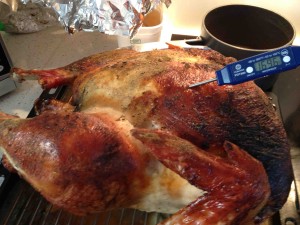Ute Reindl is the manager of an Austrian branch of a supermarket (MPREIS Warenvertriebs GmbH). In 2012 a food safety body took a sample at that branch of vacuum packed fresh turkey breast processed and packaged by another company (MPREIS being involved only at the distribution stage). The sample was contaminated by salmonella and was therefore ‘unfit for human consumption’ for the purposes of EU law1.
 The Austrian authorities brought proceedings against Ms Reindl for failure to comply with food safety rules and fined her. As Ms Reindl appealed against the fine to the Unabhängiger Verwaltungssenat in Tirol (Independent Administrative Chamber for the Land of Tyrol, Austria) which has asked the Court of Justice about the extent of liability of food business operators where they are active only at the distribution stage.
The Austrian authorities brought proceedings against Ms Reindl for failure to comply with food safety rules and fined her. As Ms Reindl appealed against the fine to the Unabhängiger Verwaltungssenat in Tirol (Independent Administrative Chamber for the Land of Tyrol, Austria) which has asked the Court of Justice about the extent of liability of food business operators where they are active only at the distribution stage.
In today’s judgment, the Court of Justice states that the fresh poultry meat referred to by EU law2 must satisfy the microbiological criteria for salmonella at all the stages of distribution including the retail sale stage. In that connection, the Court notes that the microbiological criterion applies to ‘products placed on the market during their shelf life’3. The concept of ‘products placed on the market’ refers to foodstuffs (such as the fresh poultry meat) which are held for the purpose of sale, distribution or other forms of transfer, which thereby includes retail sale. Furthermore, failure to ensure compliance with microbiological criterion at all stages of distribution (including the retail sale stage) would amount to undermining one of the fundamental objectives of food safety legislation, that is, to attain a high level of protection of human health.
The Court of Justice states, moreover, that food business operators which are active only at the distribution stage may be fined for having placed on the market a foodstuff which fails to comply with the microbiological criterion. It is clear from EU law that the Member States must set penalties for infringements of food law, which are effective, proportionate and dissuasive. The Court considers that the system of fines put in place by Austrian law may help to attain the fundamental objective of food safety law (a high level of protection of human health). However, the referring court must ensure that that system satisfies the criterion of proportionality.
1 Regulation (EC) No 178/2002 of the European Parliament and of the Council of 28 January 2002 laying down the general principles and requirements of food law, establishing the European Food Safety Authority and laying down procedures in matters of food safety (OJ 2002 L 31, p. 1).
2 Essentially, chickens, laying hens and turkeys (see Annex I to Regulation (EC) No 2160/2003 of the European Parliament and of the Council of 17 November 2003 on the control of salmonella and other specified food-borne zoonotic agents (OJ 2003 L 325, p. 1).
3 Commission Regulation (EC) No 2073/2005 of 15 November 2005 on microbiological criteria for foodstuffs, as
amended by Regulation No 1086/2011 (OJ 2005 L 281, p. 7).

 Chinese food companies in particular have been blamed for making deadly alterations to dairy, baby and pet foods by adding melamine. The chemical makes it appear that the food or beverage has the required level of protein.
Chinese food companies in particular have been blamed for making deadly alterations to dairy, baby and pet foods by adding melamine. The chemical makes it appear that the food or beverage has the required level of protein.